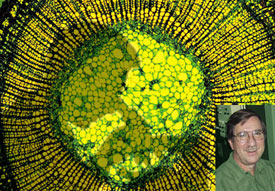The University of Texas Science Health Center at Houston
 A key to the discovery of new medications is understanding the structure and function of the surfaces of cells and their internal components. The University of Texas Health Science Center at Houston's new Center for Membrane Biology (Center), a part of the Medical School, is dedicated to advancing this understanding of the structure, function, evolution, and roles of biological membranes in cells and organelles.
A key to the discovery of new medications is understanding the structure and function of the surfaces of cells and their internal components. The University of Texas Health Science Center at Houston's new Center for Membrane Biology (Center), a part of the Medical School, is dedicated to advancing this understanding of the structure, function, evolution, and roles of biological membranes in cells and organelles.
The Center's research initiative is supported by funds from one of its oldest and most prestigious endowments, the Robert A. Welch Distinguished Chair in Chemistry. The $2.1 million endowment, invested in the Long Term Fund, dates to 1973, the Medical School's second year of operation. The current holder of the Chair, Professor John Spudich, is also the first director of the new Center for Membrane Biology.
The Center's mission is to conduct membrane research on the cutting edge, stimulate and coordinate graduate education in membrane biology, and foster career development of membrane scientists in a world-class center of research excellence. Understanding the structure and function of membrane proteins is challenging because these proteins occur in trace amounts and are more difficult than common soluble proteins to isolate and purify in functional form and in the large amounts required for detailed study. The diverse and fundamental roles that membrane proteins play in cellular processes throughout the biological world make them a new frontier of biological and biomedical research. Membrane proteins and lipids are responsible for many cell functions and are therefore vital to health. Not surprisingly, specific defects in membrane proteins and toxic effects of membrane-active substances are associated with numerous known disease states.
"Discerning the atomic structure of membrane proteins will contribute to a major change in how new medications are discovered," Spudich said. Traditionally, pharmaceutical research has begun with the random screening of millions of compounds in an attempt to identify something useful. Understanding protein atomic structure allows greater precision in drug development, an approach called rational drug design.
"Cell membrane surfaces and their exposed proteins are the most accessible targets to treat human tissue or to destroy infectious microbes," Spudich said. "More than 60 percent of medications target membrane proteins on human cells and many antibiotics target membranes on the pathogens that the drugs attack," he added.
Yet of all the tens of thousands of proteins at work in human beings, the detailed structures of only about 30 membrane proteins are known. "There's a huge disparity in knowledge between these proteins and the rest of the human proteome. That's what this center will address and I'm quite excited about its potential. Support from the Welch Chair will help a great deal with our research and in the development of the center," said Spudich.